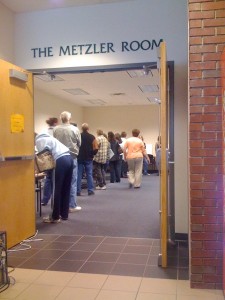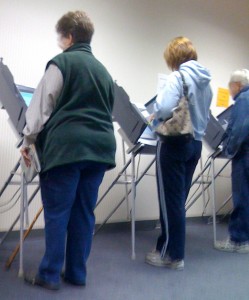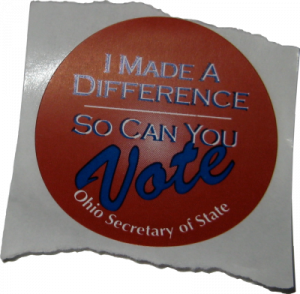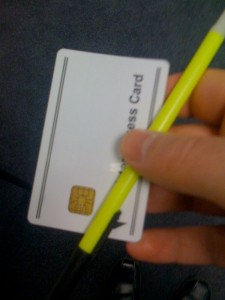Living in a “swing state” really seems to draw more attention to elections. When I was in Massachusetts and Texas, any vote I cast would make little difference in national contests, since a majority of the voters were certain to vote Democratic and Republican, respectively.
Ohio is different – parts are red (Republican), and parts are blue (Democrat), but the state-wide margin is close. I now live in a small city in rural Ohio centered around a liberal arts college, so the current presidential battle here is pitched. We’ve drawn visits from both a VP candidate and a Washington Post columnist. The Democratic secretary of state has had her hands full dealing with local resistance to changes in voting procedures, and my county still votes on Diebold touch-screen machines.
So I thought it would be worth my time to document my observations on early voting in my rural Ohio town. As in yesterday’s post on the marketing of elections, my comments are non-partisan: I’m interested in the election, but am not trying to influence your vote.
Publicity
Political signage is everywhere in town, both for the presidential contest and a wide variety of state and local contests. Driving through town, one would see about an even split between Obama and McCain signs, though some neighborhoods definitely lean one way or the other.
Our local paper has been a focal point for political commentary. Letters to the editor seem to lean towards the right, and the radical element seems over-represented, with many referring to “Hussein Obama“, William Ayres, and Rev. Wright. There have been many letters on both sides, however, and the paper has not endorsed any candidate.
We have had a multitude of robo-calls, all of them from pro-Obama celebrities, and have been visited at home three times by Obama get-out-the-vote walkers. We have received four anti-Obama mailings from the state Republican committee and one pro-Obama mailing from his campaign.
Interestingly, there is relatively little publicity for the actual process of voting. I’m glad I knew where and when to show up for early voting, but I have no idea where my regular polling place is. The same situation troubled me in Massachusetts and Texas. Elections officials need to do more to let people know when and where to vote!
Early Voting

Ohio apparently allows early voting on weekdays right up to the election. Since I will be out of town for work tomorrow, I was happy to be able to show up and cast my ballot today, one day early.
The polling place was full, with a line of about two dozen people waiting to vote and a table set up in the hall to check registration. A poll worker told me it’s been like this since early voting started, a sign of a heavy election day turnout!
Voter Verification
Before receiving an (instant) application to vote early, we were asked for our name and address but were not asked to show any ID. I was registered under the Motor Voter Law, so I never had to file any previous paperwork since I had not moved my home address.
One woman in line had recently moved, but she was allowed to vote after showing her ID. In the half hour I was at the polling place, only one person was denied entry: An older black man who apparently wasn’t listed in the registration rolls and didn’t have an ID with his current address. I am not trying to insinuate any discrimination, but this stood out somewhat since, as would be expected in a county with 95.7% white residents, he was the only non-white person there.
Applying to Vote
As mentioned, every person who came to vote early was given a form to fill out, requesting an “absentee ballot”. This form was awful – everyone around me had trouble filling it out and were asking each other for advice. Everyone I talked to about it had filled it out incorrectly!
Let’s just mention some of the issues I noticed:
- It was the same form for early voting and requesting an absentee ballot, but many people started filling out their mailing address, which was only required if a ballot was to be mailed.
- It was the same form used for primaries, so most people checked boxes other than the single “general election” box.
- Applicants were required to write in the date of the election first, and today’s date later, so most people entered the wrong date.
- One was asked to provide one of three forms of ID: An Ohio drivers’ license number, the last four digits of one’s social security number, or a bank or utility statement showing their home address. The little old lady in front of me had all three, and apologized that her bank statement didn’t have her correct address. Imagine: Some people think it’s acceptable to require a bank statement in order to vote!
All of these issues could have been solved in one of three ways, none of which were present:
- Have a poll worker instruct voters on how to fill in the form.
- Make instructional posters of flyers available
- Use a decent form
Again, I would like to stress that even though everyone around me filled in their forms incorrectly in one way or another, everyone was allowed to vote! Well, all but that one guy who was turned away before being given a form.
Paper or Electronic?
My local elections officials are at odds with Ohio’s secretary of state, Jennifer Brunner, over eliminating the disgraced touch-screen voting systems used here. Their staunch advocacy of electronic voting systems was evident at the polls, with no mention of the availability of paper ballots made by anyone. I did see two voters request and receive paper ballots, but these were fetched individually from the back room rather than being made generally available.
I was personally conflicted about the question of paper or electronic. Although I firmly believe that touch-screen systems are prone to error (and worse), I wanted to try them myself to see how well they worked. In the end, I decided to test the Diebold, lining up and accepting my smart card and stylus like the most of the rest in line.
As far as was evident, the machines worked flawlessly, with no delays or errors evident on the screen or the printed receipt. However, since votes are counted internally, not directly from the “printed ballot” or screen, one cannot be sure that their vote was cast correctly. I will just have to trust it, which really makes me nervous. I much preferred the paper ballots used back in Massachusetts.
The Ballot

The on-screen ballot itself was somewhat troubling as well. here’s what I noticed:
- There were many presidential races listed – more than a page of them! Obama was listed third on my ballot, and McCain was last, on the second screen of names.
- It was not obvious how to change one’s mind after selecting a candidate: The other boxes simply disappear once one is selected. I discovered that one could tap the selected box a second time to get the others to reappear, but this is not exactly intuitive.
- The ballot was grouped into partisan, non-partisan, and initiative sections. Most of the positions had two or more candidates listed, but some were unopposed.
- One of the initiatives (dealing with construction of a casino) was split across two screens, with all of the text on the first screen and the “yes/no” boxes standing alone on the second screen.
- Although one could review their choices prior to “casting their ballot” (printing the receipt), only the candidate names were listed. The initiatives were just listed as “Proposition 2: Yes”, making it difficult to remember and verify if the vote was cast correctly.
Closing Thoughts
My Ohio early voting experience was acceptable, but not altogether positive. I would like to see some things change in order to improve:
- Improve communication with voters regarding when and where to vote, including early voting options
- Replace the generic absentee voting form with a special simpler early-voting form
- Improve signage and communication regarding how to fill out forms and vote
- Make paper ballots more accessible
- Try some usability testing on the ballots
- Get rid of the Diebold machines already!
Note: It is legal in Ohio for a voter to take photos inside a polling place, though non-voters may not enter for any reason and no one should interfere with or publicize another person’s vote. Therefore, faces have been blurred and no ballot content is visible in the accompanying photos for this story.


The way voting and elections are run in the States is definitely in need of improvement. I’ve been living in Italy (as a citizen) for 3.5 years and have voted twice in national elections here (yeah, they happen often!).
1. Here, there’s no need to register. As soon as you reach voting age you are sent a “voter’s card”, and you can vote.
2. Voting happens on Sunday (all day) and the Monday after (until 3PM). (I suppose that early voting is an attempt to fix the huge problem of Tuesday voting.)
3. The when, the how, the where are heavily publicized, on TV and elsewhere.
4. Polling places are numerous. I have yet to encounter a single voting line.
5. At least 80% of the voting population votes (this may be because in the past voting was obligatory….)
6. Of course, Italy has a host of other problems (that would require volumes to go through), but at least the voting process makes sense.
7. Yes, I sent my ballot for this election by mail to Boston. Let’s hope it’s received and counted!
The way voting and elections are run in the States is definitely in need of improvement. I’ve been living in Italy (as a citizen) for 3.5 years and have voted twice in national elections here (yeah, they happen often!).
1. Here, there’s no need to register. As soon as you reach voting age you are sent a “voter’s card”, and you can vote.
2. Voting happens on Sunday (all day) and the Monday after (until 3PM). (I suppose that early voting is an attempt to fix the huge problem of Tuesday voting.)
3. The when, the how, the where are heavily publicized, on TV and elsewhere.
4. Polling places are numerous. I have yet to encounter a single voting line.
5. At least 80% of the voting population votes (this may be because in the past voting was obligatory….)
6. Of course, Italy has a host of other problems (that would require volumes to go through), but at least the voting process makes sense.
7. Yes, I sent my ballot for this election by mail to Boston. Let’s hope it’s received and counted!
The process of early voting should definitely be better explained. I tried to look it up before going and didn’t have a lot of luck, but figured they would explain it at the polls. It sounds like the Mansfield location was about the same as Wooster. In regards to the layout of the presidential candidates in Wooster: Interestingly, Obama was also third on my screen, but I’m pretty sure McCain was the first (green party was second). Wouldn’t that be standard? Maybe I’m remembering wrong.
The process of early voting should definitely be better explained. I tried to look it up before going and didn’t have a lot of luck, but figured they would explain it at the polls. It sounds like the Mansfield location was about the same as Wooster. In regards to the layout of the presidential candidates in Wooster: Interestingly, Obama was also third on my screen, but I’m pretty sure McCain was the first (green party was second). Wouldn’t that be standard? Maybe I’m remembering wrong.
Donato, that sounds like a great system. But I wonder how they fight fraud with those mailed cards? I definitely think we need proactive mailings to every registered voter with enough time for them to change or register if there is a problem.
Millie, I actually got a notification of my polling place early Tuesday. From an Obama GOTV person!
Donato, that sounds like a great system. But I wonder how they fight fraud with those mailed cards? I definitely think we need proactive mailings to every registered voter with enough time for them to change or register if there is a problem.
Millie, I actually got a notification of my polling place early Tuesday. From an Obama GOTV person!